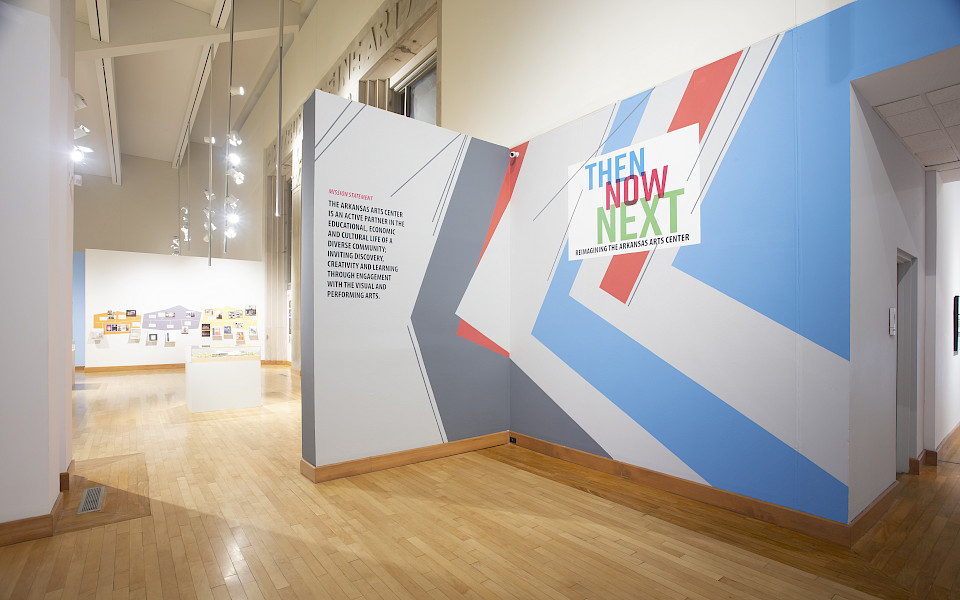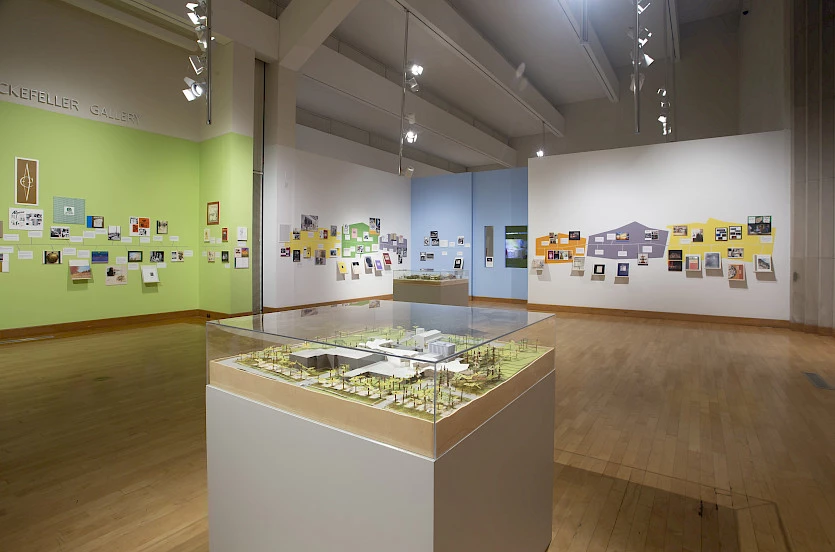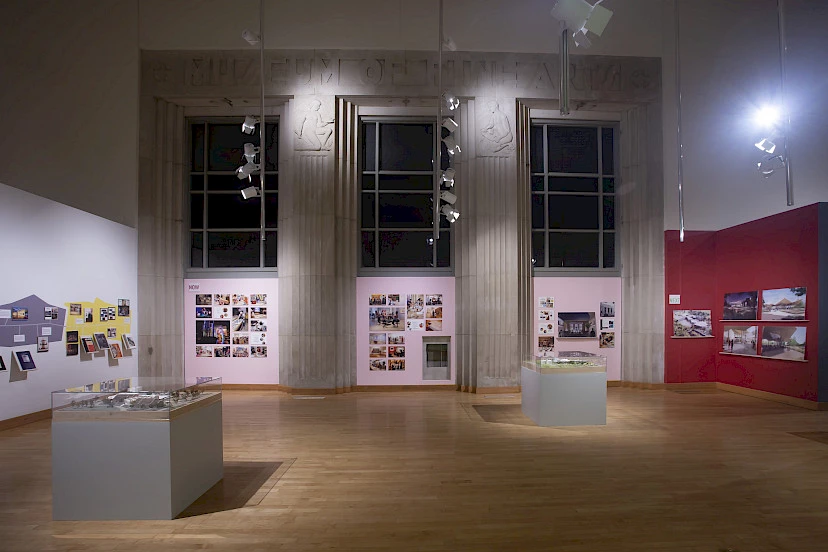


Arkansas Arts Center Explores the Past, Celebrates the Present, Imagines the Future
As the Arkansas Arts Center embarks on its transformational renovation project, Then, Now, Next: Reimagining the Arkansas Arts Center examines the Arts Center’s past, present and future. Beginning with the founding of the Fine Arts Club of Arkansas in 1914, the exhibition illustrates highlights from the Arts Center’s history, showcases current programs and offerings, and underscores the Arts Center’s ongoing commitment to the visual and performing arts. The exhibition is on view now through June 30, 2019.

The exhibition is structured in three sections: Then, Now and Next. Then features a detailed timeline of the Arts Center’s history, highlighting major milestones in the history of the building, collection, Children’s Theatre and Museum School. Now explores the Arts Center’s current programs and initiatives – from free Feed Your Mind Friday programs to Statewide ArtsReach touring programs to annual favorite exhibitions like Young Arkansas Artists, the Delta Exhibition, and the Collectors Show & Sale. Next features Studio Gang and SCAPE Studios’ concept designs for the Arkansas Arts Center’s transformational renovation, slated to open in 2022.
The story of the Arkansas Arts Center begins in 1914 with the establishment of the Fine Arts Club of Arkansas. By 1927, the club had more than 100 members, working toward the “promotion and perpetuation of the Fine Arts spirit in the State of Arkansas.” The club set its sights on building an art collection, a gallery to house the collection, and school of fine arts. In 1937, the Museum of Fine Arts, designed by H. Ray Burks and built by the Works Progress Administration, opened in what was then known as City Park. Remarks from President Franklin Delano Roosevelt were read at the dedication of the museum, in front of the north-facing Art Deco façade.

The current MacArthur Park building is made up of eight additions to the original 1937 structure. In 1957, the Little Rock City Council granted the museum authority to expand its physical footprint – and with that expansion, the Museum also expanded its mission and changed its name. Winthrop and Jeannette Edris Rockefeller joined the Fine Arts Club and Junior League of Little Rock to create an Arts Center that would serve the entire state. Rockefeller led the fundraising campaign for the new Arkansas Arts Center, emphasizing the role of residents in contributing to build an institution that world serve all of Arkansas. Businesses and individuals from all parts of the state – including children who saved nickels and dimes in jars – made donations. In 1960, the Little Rock Board of Directors adopted an ordinance officially establishing the Arkansas Arts Center, and the new building opened in 1963. The building was also renovated and/or expanded in 1971, 1981, 1982, 1989, 2000 and 2001. Then, Now, Next is on view in the Winthrop Rockefeller Gallery, which prominently features the original 1937 façade as a backdrop (it was built into the gallery walls as part of the 1982 expansion).
Then also notes significant developments in collections, exhibitions and programming history of the Arkansas Arts Center. The timeline highlights significant acquisitions to the Arkansas Arts Center Foundation Collection, including gifts from newspaperman Fred W. Alllsopp and the New York-based Samuel H. Kress Foundation in the 1930s, Abby Rockefeller Mauzé’s 1955 gift of Diego Rivera’s Dos Mujeres, and David Rockefeller’s 1963 gift of Odilon Redon’s Andromeda, among others. The timeline looks at the shift to collecting works on paper and contemporary craft under the direction of longtime executive director Townsend Wolfe. It traces the establishment of many of the Arts Center’s signature exhibitions – the Delta Exhibition in 1958, Young Arkansas Artists in 1961, National Drawing Invitational in 1985 and National Objects Invitational in 1987. The timeline also looks at the introduction of important Arts Center programs – the establishment of the Artmobile in 1961, the evolution of the theatre from community performances to professional productions for children and families, and the development of the Museum School.
Now looks at the ways the Arts Center is currently serving Central Arkansas and statewide communities. The Arts Center welcomes more than 200,000 visitors annually to its facility in historic MacArthur Park. Roughly 40,000 children and families and over 200 schools from across the state visit the Children’s Theatre each year. Another 53,000 attend Children’s Theatre on Tour performance or tour the Artmobile.
Next features design concept images for the reimagined Arkansas Arts Center by Studio Gang Architects. Studio Gang was named design architect for the transformational renovation project in 2016. Founded by MacArthur Fellow Jeanne Gang, Studio Gang is an award-winning architecture and urbanism practice based out of Chicago and New York. A recipient of the 2013 National Design Award, Jeanne Gang was also named the 2016 Architect of the Year by the Architectural Review and the firm was awarded the 2016 Architizer A+ award for Firm of the Year. Gang was also named to TIME Magazine’s list of the 100 most influential people of 2019. Recently, Studio Gang was successful in the design competition to lead the $8.5 billion reimagining of Chicago’s O’Hare Airport Global Terminal and Global Concourse.
Studio Gang is recognized internationally for its design process that foregrounds the relationships between individuals, communities and environments. The firm has extensive knowledge in museum, theatre and artist studio spaces, including their work on the Writers Theatre in Glencoe, Ill. With its design for the Writers Theatre, Studio Gang sought to “maximize this potential for a twenty-first-century theater company, creating an architecture that energizes the daily life of its community and becomes an exciting, region-wide cultural destination.” Other recent projects have included the new U.S. embassy in Bazil, the Gilder Center for Science, Education and Innovation at the American Museum of Natural History, and the Memphis Riverfront Concept.
Studio Gang’s concept design for the Arkansas Arts Center lends a new, highly visible architectural identity to the Arts Center. Reorganizing and ordering the current program and architectural envelope, Studio Gang has designed a pleated, organic architecture that connects the new north-facing city entrance with the new glass pavilion and south-facing park entrance to create an open axis public gallery through the building, connecting the program components of the Arts Center. SCAPE Studios’ designs for MacArthur Park present a vision of the Arkansas Arts Center as a “museum within the park.” Drawing inspiration from Little Rock’s unique regional ecologies – including the banks of Fourche Creek, the bluffs of Emerald Park, and the agrarian landscapes of the Mississippi Delta – the landscape design features inviting outdoor spaces that contribute to AAC’s role as a cultural beacon for Arkansas.
Then, Now, Next: Reimagining the Arkansas Arts Center was organized by the Arkansas Arts Center.